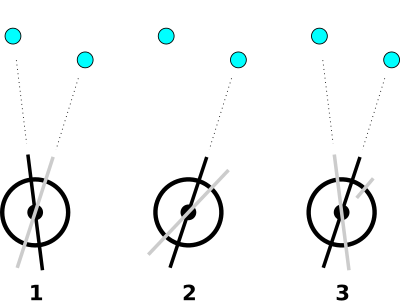

The repeating circle is an instrument for geodetic surveying, developed from the reflecting circle by Étienne Lenoir in 1784. He invented it while an assistant of Jean-Charles de Borda, who later improved the instrument. It was notable as being the equal of the great theodolite created by the renowned instrument maker, Jesse Ramsden. It was used to measure the meridian arc from Dunkirk to Barcelona by Jean Baptiste Delambre and Pierre Méchain (see: meridian arc of Delambre and Méchain).
Construction and operation
The repeating circle is made of two telescopes mounted on a shared axis with scales to measure the angle between the two. The instrument combines multiple measurements to increase accuracy with the following procedure:

(1) The instrument is aligned so its plane includes the two points to be measured, and each telescope is aimed at a point;
(2) Keeping the angle between the telescopes locked, the left (black) telescope is rotated clockwise to aim at the right point;
(3) the right (gray) telescope's position is noted, and it is rotated back to the left point.
At this stage, the angle on the instrument is double the angle of interest between the points. Repeating the procedure causes the instrument to show 4× the angle of interest, with further iterations increasing it to 6×, 8×, and so on. In this way, many measurements can be added together, allowing some of the random measurement errors to cancel out.
See also
References
- Daumas, Maurice (1989). Scientific Instruments of the Seventeenth and Eighteenth Centuries and Their Makers. London: Portman Books. ISBN 978-0-7134-0727-3.
- Alder, Ken (2002). The Measure Of All Things. Simon and Schuster. ISBN 0-7432-1675-X.
This history of science article is a stub. You can help Misplaced Pages by expanding it. |
This article about a civil engineering topic is a stub. You can help Misplaced Pages by expanding it. |
This standards- or measurement-related article is a stub. You can help Misplaced Pages by expanding it. |